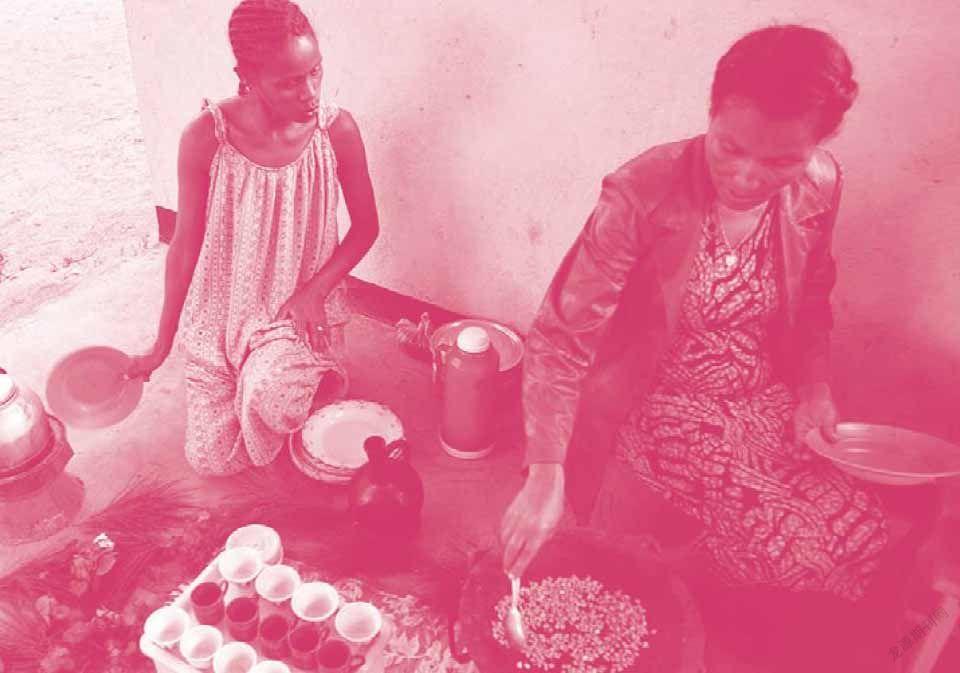Coffees Around the World世界各地的咖啡
2019-09-10孙美萍
孙美萍

世界各地的咖啡
From the simple Italian espresso shot to traditional Turkish coffee ceremonies, see how people around the world take their cup of coffee. 從简单的意大利特浓咖啡到传统的土耳其咖啡仪式,让我们一起去探索世界各地的人们是如何享用咖啡的。
Italy: Espresso
You’ll surely get an eye roll or two if you order a to-go cup at an Italian cafe, for espresso is the Italians’ version of to-go coffee. This strong brew served in tiny cups is commonly sipped while standing at cafes. Sometimes, a slice of lemon is rubbed around the edge of the cup to give some additional flavor. Also, cappuccino is actually only made in the morning.
Turkey: Türk Kahvesi
A famous Turkish proverb says that coffee should be “as black as hell, as strong as death and as sweet as love.” This thick brew is usually served after meals from a long-handled copper pot called a cezve, accompanied by chewy Turkish candy.
Denmark: Kaffee
Perhaps because of the cold, dark Scandinavian winters, coffee consumption in Denmark has historically been one of the highest. Coffee is such a vital part of the Danish culture that packed cafes can be found on nearly every corner, especially in cities such as Copenhagen.
France: Café au Lait
The French begin the day with their café au lait1—coffee with hot milk, served in a mug wide enough to allow the dunking of baguettes or croissants.
Germany: Kaffee & Kuchen
The Germans love to have their afternoon coffee with cake, called Kaffee & Kuchen, it is also a means to welcome guests, and spend time with family and friends. Coffee houses were so popular, that Johann Sebastian Bach even composed a mini-opera, called Coffee Cantata, which tells the story of a girl’s addiction to coffee.
Cuba: Café Cubano
Cubans like their coffee strong, whether it’s first thing in the morning, after meals or at any chance they get throughout the day. An important part of the social fabric, the Cuban’s strong brew is served in shots and best enjoyed while socializing.
Colombia: Tinto
Colombia, known for its great, versatile coffee beans, likes its coffee black with sugar, in small cups. Called Tinto, it’s often sold in six-ounce cups on the street of Colombia and is typically enjoyed in the late afternoon or after dinner. Interestingly, Colombians themselves are not very fond of it, and prefer aguapanela, a drink made from water and cane sugar.
Brazil: Cafezinho
In the Brazilian city of Sao Paulo, small cafes and local Starbucks stores serve cafezinho, a hot doppio espresso with a touch of sugar. It’s served with a small pastry on the side. The cafezinho is a popular ritual in the afternoon when friends join together in conversation or coworkers connect before heading back to work.
Saudi Arabia: Kahwa
In Saudi Arabia and other Arab cultures, coffee ceremonies follow many rules of etiquette, including always serving the elders first. Saudi coffee (called “kahwa”) is dark, horrendously bitter, and flavored with cardamom. In fact, the coffee is usually served with sweet dates to cut the flavor.
Finland: Kaffeost
Kaffeost, or “coffee cheese,” originated in Finland and can also be found in the north of Sweden near the Finnish border. It’s a relatively firm, mild cheese that takes on a creamier consistency and sweeter flavor when topped with hot coffee made from finely ground beans.
Ireland: Irish Coffee
Coffee meets cocktail with this after-dinner drink. Irish coffee includes hot coffee, Irish whiskey, sugar and the crowd-pleasing whipped-cream2 topper. Irish coffee was actually created in Ireland in the 1940s to warm up American tourists on a cold winter’s night, and it remains as popular as ever today.
Mexico: Café de Olla
If you like cinnamon in your coffee, this is your drink. Spiced café de olla is brewed with cinnamon sticks in earthenware pots, which Mexicans swear brings out the coffee taste.
Ethiopia: Buna
In Ethiopia, the birthplace of coffee, traditional coffee ceremonies are a distinguished part of the culture, with the brewing and serving process lasting up to two hours. Historically, buna, as coffee is called here, was served with salt or butter instead of sugar.
Senegal: Café Touba
Café Touba is made similarly to drip coffee and flavored with Guinea pepper, or djar3, and occasionally cloves. It takes its name from the holy city of Touba. Originally believed to have medicinal value, this sweet and spicy coffee drink is now enjoyed throughout the morning and afternoon in Senegal. Touba stands are found on every street corner in Dakar.
Austria: Mélange
Served in Viennese cafes, Austria’s traditional drink, mélange, is very similar to a cappuccino. It contains espresso and steamed milk and is topped with froth or, sometimes, whipped cream (which is what makes it different from a traditional cappuccino).
Greece: Frappé
The Greek frappé is a frothy iced drink made with Nescafé instant coffee, cold water, sugar and evaporated milk4. It’s best enjoyed in an outdoor cafe.
Indonesia: Kopi Luwak
Though this might make your skin crawl slightly, there is something in Indonesia called “kopi luwak.” In order to get the right roast and flavor, the kopi beans must first pass through the digestive tract of a civet. Yeah, you read that right. The beans are harvested from the civet’s droppings then roasted. It is absurdly overpriced in Indonesia, but tourists and locals love drinking it up.
Vietnam: Cà Phê Trứng
Also known as Vietnamese egg coffee, this caffeinated treat could almost pass for dessert. Egg yolks are whisked together with condensed milk and sugar, creating a custard-like topping that makes this slow-brewed beverage a nationwide favorite. Any dark, strong blend will work, although robusta beans are most commonly used for Cà Phê Trứng. Egg coffee can be enjoyed either hot or iced and is an absolute must-try for visitors to Hanoi or Ho Chi Minh City.
意大利:特浓咖啡
如果在一家意大利咖啡馆点一杯咖啡带走喝,你绝对会受到别人的白眼,因为特浓咖啡就是意大利人眼中的外带咖啡。这种咖啡很浓郁,装在非常小的杯子中,通常是站在咖啡馆里小口喝完的。有时拿一片柠檬沿杯子边缘涂抹一圈,带来别样的风味。另外,实际上只有在早上才会制作卡布奇诺。
土耳其:土耳其咖啡
一句著名的土耳其谚语形容咖啡应“黑如地狱,浓如死亡,甜如爱情”。这种浓厚的咖啡通常在饭后搭配土耳其咀嚼糖享用,盛咖啡的容器是一把长柄铜壶,被称作土耳其咖啡壶。
丹麦:丹麦咖啡
也许是由于斯堪的纳维亚的冬天寒夜漫漫,历史的咖啡消费之高可位列世界史上头几名。在丹麦文化中,咖啡扮演着重要角色,几乎每个角落都能看到挤满了人的咖啡馆,尤其是在哥本哈根这样的城市。
法国:欧蕾咖啡
法国人的一天始自欧蕾咖啡——把热牛奶冲入咖啡中,倒入足够宽的马克杯,以方便浸泡法棍面包或牛角面包。
德国:咖啡和蛋糕
德国人喜爱在喝下午茶时搭配蛋糕,这种方式被称作“咖啡和蛋糕”。同样,这也是一种迎接客人以及和家人朋友消磨时光的方式。咖啡厅非常受欢迎,约翰·塞巴斯蒂安·巴赫甚至因此创作了一部名为《咖啡康塔塔》的迷你歌剧,讲述了一个女孩沉迷于咖啡的故事。
古巴:古巴咖啡
不管是清早还是饭后,或一天中任何时候,古巴人都喜欢喝浓郁的咖啡。浓郁的古巴咖啡是社会架构的重要组成部分,小份饮用,在社交中广受欢迎。
哥伦比亚:纯黑咖啡
哥伦比亚因其优质多样的咖啡豆而著名,盛行小杯加糖的纯咖啡。这种咖啡被称作纯黑咖啡,通常以六盎司杯装在哥伦比亚大街上售卖,人们通常在傍晚或晚饭过后享用。有趣的是,哥伦比亚人却没那么喜欢它,而更钟情于一种用水及蔗糖做成的饮品——蔗糖水。
巴西:小咖啡
在巴西圣保罗,小咖啡馆及当地的星巴克咖啡店都会供应小咖啡,这是一种加有少许糖的双倍特浓咖啡,和一小块油酥点心一起享用。朋友们下午相聚闲聊及同事在工作间隙沟通交流时一起品用小咖啡非常普遍。
沙特阿拉伯:夸瓦
在沙特阿拉伯及其他阿拉伯文化中,咖啡仪式要遵循许多规矩礼节,包括请年长者先用。沙特阿拉伯咖啡(kahwa)味道很重,相当苦,用豆蔻调味。实际上,人们经常用甜枣来缓解它的味道。
芬兰:芝士咖啡
芝士咖啡,或者说“咖啡芝士”,源于芬兰,在接近芬兰边界的瑞典北部也可以见到。这是一種相对坚硬、味道较淡的芝士,当浇上用咖啡豆磨成的细粉制成的热咖啡时,便会拥有更为持久的奶味及更甜的口味。
爱尔兰:爱尔兰咖啡
爱尔兰咖啡是餐后饮品,实现了咖啡与鸡尾酒的结合。爱尔兰咖啡包含热咖啡、爱尔兰威士忌、糖及掼奶油,顶部的掼奶油广受喜爱。爱尔兰咖啡实际上发明于20世纪40年代的寒冷冬夜,为了让美国的游客们暖和起来,直到今天都很受欢迎。
墨西哥:陶壶咖啡
这种咖啡就是为喜欢在咖啡中放入肉桂的人准备的。陶壶咖啡是在陶壶里放入肉桂条调制而成,有香料的味道。墨西哥人坚信陶壶可以煮出咖啡的味道。
埃塞俄比亚:布纳
埃塞俄比亚是咖啡的发源地,传统的咖啡仪式是埃塞俄比亚文化非常重要的组成部分,调制咖啡及上咖啡的过程可达两小时之久。在历史上,布纳(埃塞俄比亚对咖啡的叫法)不加糖,而是加盐或黄油。
塞内加尔:图巴咖啡
图巴咖啡和滴滤咖啡的做法相似,用几内亚胡椒(djar)调味,有时也会用丁香。图巴咖啡的名字源于圣城图巴。最初,人们相信它有药用功效;如今,在塞内加尔,人们会在早上及下午享用这种甜而辛辣的咖啡饮品。在达喀尔的每个街角都可以找到图巴咖啡馆。
奥地利:混合咖啡
维也纳咖啡馆供应奥地利的传统饮品混合咖啡。混合咖啡和卡布奇诺非常相似,包含意大利特浓咖啡及热蒸奶,顶部会打上奶沫,有时也会打上掼奶油(这正是混合咖啡和传统的卡布奇诺不同之处)。
希腊:冰咖啡
希腊冰咖啡属于起泡冰饮,用雀巢速溶咖啡、冷水、糖及淡奶制成,最适合在露天咖啡馆享用。
印度尼西亚:猫屎咖啡
虽然这可能会让你起鸡皮疙瘩,但是在印度尼西亚确实存在所谓的“猫屎咖啡”。为了获得良好的烘焙效果及优质的口味,咖啡豆必须先从麝香猫的消化道中过一遍。是的,你没有看错。之后,从麝香猫的粪便提取出咖啡豆并进行烘焙。在印度尼西亚,猫屎咖啡的价格高得出奇,但是游客们和当地人喜欢将它一饮而尽。
越南:蛋咖啡
蛋咖啡也被称作越南鸡蛋咖啡,这种含有咖啡因的饮品几乎可以充当甜品。把蛋黄、炼乳及糖放在一起搅拌,形成类似蛋奶沙司一样的浇头。这种饮品调制起来很慢,在越南广受喜爱。任何经过深度烘培、味道浓郁的咖啡豆都能调制蛋咖啡,但通常多采用罗布斯塔咖啡豆。无论是热饮还是冰饮,蛋咖啡都很好喝,同时这也是游览河内或胡志明市的游客必尝饮品。 □
(译者为“《英语世界》杯”翻译大赛获奖选手)
